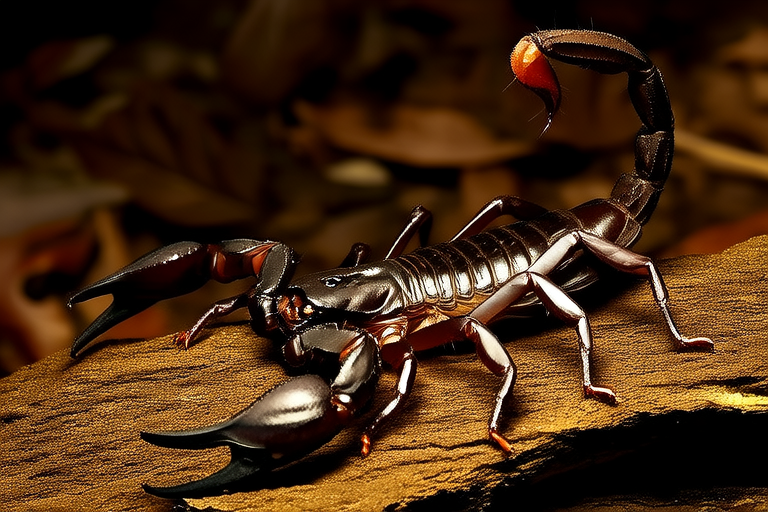The Top 5 Fascinating Facts About the Heterometrus Spinifer You Need to Know
Scorpions are one of nature’s most fascinating creatures, and the Heterometrus spinifer is no exception. This species, commonly known as the Indian forest scorpion, has intrigued scientists and animal enthusiasts alike with its unique characteristics and behaviors. Here are five fascinating facts that will make you appreciate the complexity and wonder of this creature.
1. Unique Adaptations for Survival
The Heterometrus spinifer is equipped with an array of adaptations that help it thrive in its natural habitat. One of the most remarkable features of this scorpion is its ability to withstand extreme temperatures. Recent studies have shown that these scorpions can survive in environments with temperatures ranging from 10°C to 40°C. This adaptability is due to their thick exoskeleton, which acts as an insulator, protecting them from both heat and cold. Additionally, they have specialized sensory organs on their pincers called pectines, which help them detect vibrations and changes in humidity. These organs play a crucial role in navigation and prey detection, especially in the dense underbrush where they typically reside.
Another notable adaptation is the presence of venom glands located at the base of their stinger. The venom of the Heterometrus spinifer contains neurotoxins that paralyze small prey, such as insects and spiders, making hunting more efficient. Interestingly, the potency of the venom varies depending on the age and health of the scorpion. Younger scorpions tend to produce less potent venom, which suggests that they rely more on their physical strength to subdue prey until their venom becomes more effective as they mature.
2. Complex Social Behavior
Contrary to popular belief, scorpions are not entirely solitary creatures. The Heterometrus spinifer
is known to exhibit social behaviors that are quite unusual for arachnids. Recent research has revealed that these scorpions sometimes aggregate in groups during certain times of the year, particularly during mating season or when seeking shelter from harsh weather conditions. These gatherings can include up to a dozen individuals, and they often share burrows or dens. Scientists believe that this behavior may be linked to increased survival rates, as communal living provides protection against predators and ensures access to resources.
Moreover, studies have shown that Heterometrus spinifer females display maternal care towards their offspring. After giving birth, the mother carries her young on her back for several days until they are capable of hunting on their own. This level of parental investment is rare among arachnids and underscores the complexity of social interactions within this species.
3. Camouflage and Hunting Strategies
The Heterometrus spinifer employs various strategies to remain hidden from both predators and potential prey. Its dark brown to black coloration blends seamlessly with the leaf litter and soil of its forest habitat, providing excellent camouflage. Furthermore, this scorpion has developed specific behaviors to avoid detection. For instance, it often remains motionless for extended periods, only moving when necessary to hunt or escape danger. When it does move, it does so with remarkable stealth, relying on its powerful legs to navigate through the dense vegetation without making much noise.
Once it locates a suitable hiding spot, the Heterometrus spinifer constructs a burrow that serves as both a refuge and a launching pad for ambush attacks. These burrows are typically shallow and wide enough to accommodate the scorpion’s body but narrow enough to prevent larger predators from entering. By positioning itself at the entrance of the burrow, the scorpion can strike quickly at passing insects or other small animals that venture too close.
4. Venomous but Not Deadly
While the venom of the Heterometrus spinifer is potent enough to immobilize its prey, it is generally not lethal to humans. In fact, many people who have been stung by this species report only mild pain and swelling, similar to that of a bee sting. However, the severity of the reaction can vary depending on factors such as individual sensitivity and the amount of venom injected.
Recent studies have explored the potential medical applications of Heterometrus spinifer venom. Researchers have identified several compounds within the venom that could be used to develop new drugs for treating conditions like chronic pain and epilepsy. These compounds work by targeting specific ion channels in nerve cells, which could lead to more precise and effective treatments with fewer side effects compared to current medications.
5. Longevity and Reproduction
The lifespan of the Heterometrus spinifer is relatively long for an arachnid, typically ranging from 6 to 8 years in the wild. During this time, females reach sexual maturity around 2 years of age, while males take slightly longer, usually maturing between 2.5 and 3 years. Once sexually mature, reproduction occurs through a process known as traumatic insemination. In this method, the male uses his modified pedipalps (claws) to transfer sperm directly into the female’s reproductive tract. This process can sometimes result in injury to the female, which is why successful mating events are relatively rare in captivity.
After mating, the female undergoes a gestation period lasting approximately 9 months before giving birth to live young. Litter sizes can range from 10 to 40 offspring, depending on environmental conditions and the health of the mother. The newborn scorpions are born fully formed but lack the ability to hunt independently, relying instead on their mother for protection and nourishment until they are old enough to fend for themselves.
